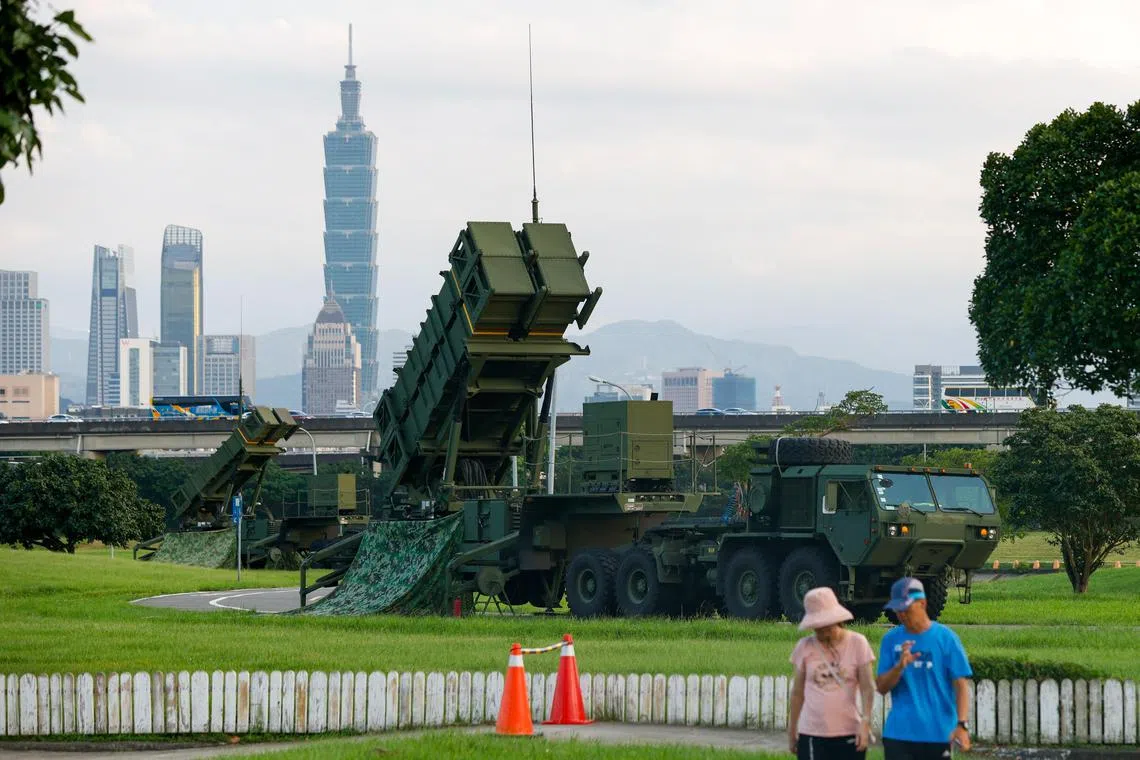Taipei holds air raid drill on July 17 to prepare for Chinese attack
Sign up now: Get ST's newsletters delivered to your inbox

A Patriot air defence system, which can detect and destroy incoming missiles, being deployed at a park in Taipei as part of Taiwan's annual Han Kuang military exercises on July 15.
PHOTO: EPA
Follow topic:
TAIPEI – Taipei’s normally busy streets came to a brief standstill on July 17 when air raid sirens forced thousands of people off the streets and into underground shelters in a rehearsal for a Chinese attack.
The annual civilian drills are being held in cities across Taiwan this week, alongside military training, to prepare the self-governed island for a potential Chinese invasion.
While Communist China has never ruled Taiwan, Beijing insists the island is part of its territory and has threatened to use force to bring it under its control.
At 1.30pm, sirens sounded across Taipei, bringing the capital city of 2.5 million people to a halt for half an hour.
Motorbikes, cars and public buses stopped on the street and people were directed into shelters, including underground carparks and subway stations.
Some people retreated into office buildings or convenience stores for the duration of the exercise.
The drills will also involve simulating wartime aid distribution and a mass casualty event.
Since taking office in 2024, Taiwanese President Lai Ching-te has sought to raise public awareness of the threat posed by China.
Referring to the drills, 25-year-old Oscar Wang said: “This is necessary because tensions across the strait are so high right now. So it’s important to let us, ordinary people, become more familiar with evacuation routes.”
‘Reality of modern warfare’
Taiwan is also keen to show the world, especially its key security backer Washington, that it is serious about boosting its defence capability.
Taiwanese regular troops were joined by the largest-ever mobilisation of reservists for the 10-day Han Kuang military drills
Rather than only repelling a Chinese attack on its shores, Taiwanese troops in 2025 have also practised fighting invading forces on city streets.
“It is as much training as acclimating the Taiwanese population to the reality of modern warfare,” said Mr Kitsch Liao of the Atlantic Council, a US think-tank.
Heavily armed troops carrying US-provided anti-aircraft Stinger missiles stormed Taipei’s metro system in a night-time exercise.
High-tech mobile missile launchers from the US also have been positioned around the capital and elsewhere, in full view of the public.
Shoppers in a Taipei supermarket recently became participants in a drill simulating a Chinese missile strike on the city.
“I didn’t know there was going to be a drill,” 70-year-old Yang Shu-ting told AFP. “My heart was beating very fast, and I was inevitably nervous. I think the point is to let you know where you should hide if something happens.”
Troops have also simulated various scenarios including “grey zone harassment” or tactics that fall short of an act of war and “long-range precision strikes”, defence officials said.
Several minor collisions involving military vehicles during the exercises highlighted the challenge of manoeuvring through Taiwan’s narrow streets.
Defence expert Chieh Chung said such accidents were “difficult to avoid” in urban areas.
“In Taiwan, many roads and bridges create significant limitations for armoured vehicles when they move through,” said Associate Professor Chieh, a researcher at the Association of Strategic Foresight in Taipei.
“So this becomes a problem and obstacle for both attacking and defending forces.” AFP

